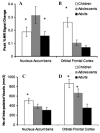The adolescent brain
- PMID: 18400927
- PMCID: PMC2475802
- DOI: 10.1196/annals.1440.010
The adolescent brain
Abstract
Adolescence is a developmental period characterized by suboptimal decisions and actions that are associated with an increased incidence of unintentional injuries, violence, substance abuse, unintended pregnancy, and sexually transmitted diseases. Traditional neurobiological and cognitive explanations for adolescent behavior have failed to account for the nonlinear changes in behavior observed during adolescence, relative to both childhood and adulthood. This review provides a biologically plausible model of the neural mechanisms underlying these nonlinear changes in behavior. We provide evidence from recent human brain imaging and animal studies that there is a heightened responsiveness to incentives and socioemotional contexts during this time, when impulse control is still relatively immature. These findings suggest differential development of bottom-up limbic systems, implicated in incentive and emotional processing, to top-down control systems during adolescence as compared to childhood and adulthood. This developmental pattern may be exacerbated in those adolescents prone to emotional reactivity, increasing the likelihood of poor outcomes.
Conflict of interest statement
Conflict of Interests
The authors declare no conflicts of interest.
Figures







References
-
- Adriani W, Chiarotti F, Laviola G. Elevated novelty seeking and peculiar d-amphetamine sensitization in periadolescent mice compared with adult mice. Behav Neurosci. 1998;112(5):1152–1166. - PubMed
-
- Andersen SL, Teicher MH. Delayed effects of early stress on hippocampal development. Neuropsychopharmacology. 2004;29(11):1988–1993. - PubMed
-
- Andersen SL, Thompson AT, Rutstein M, Hostetter JC, Teicher MH. Dopamine receptor pruning in prefrontal cortex during the periadolescent period in rats. Synapse. 2000;37(2):167–169. - PubMed
-
- Baird AA, Gruber SA, Fein DA, Maas LC, Steingard RJ, Renshaw PF, et al. Functional magnetic resonance imaging of facial affect recognition in children and adolescents. J Am Acad Child Adolesc Psychiatry. 1999;38(2):195–199. - PubMed
Publication types
MeSH terms
Grants and funding
LinkOut - more resources
Full Text Sources
Medical

